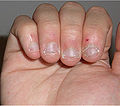- Impulse control disorder
-
Impulse control disorder Classification and external resources ICD-10 F63 ICD-9 312.3 MeSH D007174 Impulse control disorder is a set of psychiatric disorders including intermittent explosive disorder, kleptomania, pathological gambling, pyromania (fire-starting), and three body-focused repetitive or compulsive behaviors of trichotillomania (a compulsion to pull one's hair out), onychophagia (compulsive nail biting) and dermatillomania (compulsive skin picking). The onset of these disorders usually occurs between the ages of 7 and 15.[1] Impulsivity, the key feature of these disorders, can be thought of as seeking a small, short term gain at the expense of a large, long term loss. Those with the disorder repeatedly demonstrate failure to resist their behavioral impetuosity. (See also 'behavioral addiction)
Contents
Classification
Considered to be part of the obsessive-compulsive disorder spectrum,[2] impulse control disorders are often associated with substance use disorders because "it has been speculated that these disorders are mediated by alterations of partially overlapping neural circuits".[3]
Treatment
Impulse control disorders have two treatment options: psychosocial and pharmacological.[4] Treatment methodology is informed by the presence of comorbid conditions.[5]
See also
- Body-focused repetitive behavior
- Child pyromaniac
References
- ^ Kessler RC, Amminger GP, Aguilar-Gaxiola S, Alonso J, Lee S, Ustün TB (2007). "Age of onset of mental disorders: a review of recent literature". Curr Opin Psychiatry 20 (4): 359–64. doi:10.1097/YCO.0b013e32816ebc8c. PMC 1925038. PMID 17551351. http://www.pubmedcentral.nih.gov/articlerender.fcgi?tool=pmcentrez&artid=1925038.
- ^ Brain Explorer - Focus on Brain Disorders - OCD - Related Spectrum Disorders
- ^ Fontenelle LF, Oostermeijer S, Harrison BJ, Pantelis C, Yücel M (May 2011). "Obsessive-compulsi ve disorder, impulse control disorders and drug addiction: common features and potential treatments". Drugs 71 (7): 827–40. doi:10.2165/11591790-000000000-00000. PMID 21568361.
- ^ Grant JE, Potenza MN, Weinstein A, Gorelick DA (September 2010). "Introduction to behavioral addictions". Am J Drug Alcohol Abuse 36 (5): 233–41. doi:10.3109/00952990.2010.491884. PMC 3164585. PMID 20560821. http://www.pubmedcentral.nih.gov/articlerender.fcgi?tool=pmcentrez&artid=3164585.
- ^ Dell'Osso B, Altamura AC, Allen A, Marazziti D, Hollander E (December 2006). "Epidemiologic and clinical updates on impulse control disorders: a critical review". Eur Arch Psychiatry Clin Neurosci 256 (8): 464–75. doi:10.1007/s00406-006-0668-0. PMC 1705499. PMID 16960655. http://www.pubmedcentral.nih.gov/articlerender.fcgi?tool=pmcentrez&artid=1705499.
External links
- University of Minnesota Impulse Control Disorders Clinic Provides useful information and resources for patients and their families, including free questionnaire-based rating scales that patients can use to assess and track the severity of their condition.
-
Container after pyromania attack
-
Dermatillomania pattern and effect on the skin
-
Nail biting or Onychophagia
This abnormal psychology-related article is a stub. You can help Wikipedia by expanding it.




